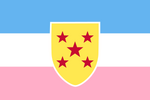Mário Martins, a Brazilian writer, states that the inscription originates from the motto of the Jesuit order: "Work as if everything depended on you, and trust as if everything depended on God." Despite being an unusual color in heraldry, rose was used by the creators of the flag in order to represent a shade found in the capixaba sky, which, during summer afternoons, presents changing shades of pink mixed with sky blue.
The Espírito Santo flag dates from 1908 but was adopted officially on 24 April 1947 by Governor Carlos Fernando Montero Lindemberg. The blue and rose are the official colors of the state, instituted by Jerónimo Monteiro on 7 September 1909. Apparently they were the colors of an abolitionist club, as well as those of the dress of the Virgin of the Victory, patron of the capital of the state. The blue represents smoothness and harmony, the white peace, and the rose rejoicing and happiness. The words Trabalha e Confia (Work and Trust [in God]) are attributed to Governor Monteiro. They have to have their origin in his religious training with the Association of São Luis do Itu (São Paulo), directed by the fathers of the Society of Jesus (Jesuits) founded by St. Ignatius Loyola.
A diagram signed (apparently by the then governor and referring to the original Decree) in March 1982 indicates the flag has overall proportions 7:10, however, from the diagram we may note that the stripes are in proportions of 9-10-9 rather than even, with the motto contained within an imaginary rectangle equal to 11/20 of flag length across by 6/10 of the central stripe high. The exact colors still remain slightly conjectural, none-the-less. The flag at http://www.vexilla-mundi.com/brazil_divisions.html is based on a photo of a flag in actual use and the shades are rather brighter than we show?
That seems odd--the 1947 decree-law on the flag said "A bandeira do Estado terá as dimensões estabelecidas para a bandeira nacional, em três campos - azul, branco e rosa - retangulares, longitudinais e iguais..." (The flag of the State will have the dimensions established for the national flag, in three fields - blue, white, and pink - rectangular, longitudinal, and equal." I wonder why they'd go from equal to unequal, other than perhaps to satisfy the Brazilian impulse to give flag dimensions in "modules". Having a hoist equal to 28 modules would allow stating the fly as exactly 40, but then it would seem just as easy to state the hoist as 7+7+7 with the fly equal to 30. Perhaps the math for the arc and the height of the letters ends up in fractions that way?
The official diagram gives the overall proportions as 14 modules by 20 modules, then stripes in ridiculous proportions of 4.5 modules, 5 modules and 4.5 modules, with 1.5 modules at the top of bottom of the lettering and 4.5 modules at the hoist and at the fly.
Proposed flags[]






